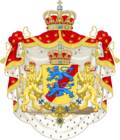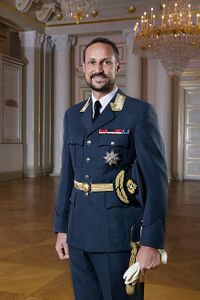Monarchy of Scanonia: Difference between revisions
(Created page with "{{Infobox monarchy | royal_title = King | realm = Scanonia | native_name = ''Skånskarnas konung'' | coatofarms = Great Coat of arms of Scan...") |
No edit summary |
||
| Line 7: | Line 7: | ||
| incumbent = [[Frederick VIII of Scanonia|Frederick VIII]] | | incumbent = [[Frederick VIII of Scanonia|Frederick VIII]] | ||
| incumbentsince = 21st of July 2009 | | incumbentsince = 21st of July 2009 | ||
| image = | | image = King Frederick of Scanonia.jpg | ||
| heir_apparent = [[Charles, Crown Prince of Scanonia]] | | heir_apparent = [[Charles, Crown Prince of Scanonia]] | ||
| first_monarch = [[Gustav the Wise]] | | first_monarch = [[Gustav the Wise]] | ||
| Line 13: | Line 13: | ||
| date = Unknown, around 4th century AD | | date = Unknown, around 4th century AD | ||
| residence = Kristianstad Palace | | residence = Kristianstad Palace | ||
| website = | | website = kungahuset.sk | ||
}} | }} | ||
The '''monarchy of Scanonia''' is {{wp|constitutional monarchy|constitutional}}, {{wp|inheritance|hereditary}} and {{wp|popular monarchy|popular}} monarchy with a {{wp|parliamentary system}}. | The '''monarchy of Scanonia''' is {{wp|constitutional monarchy|constitutional}}, {{wp|inheritance|hereditary}} and {{wp|popular monarchy|popular}} monarchy with a {{wp|parliamentary system}}. | ||
The [[Scanonia|Kingdom of Scanonia]] has been a monarchy since {{wp|time immemorial}}, while from 17th century up until [[Great Astyrian War]] Scanonia was in a personal union with [[Noordenstaat]]. | The [[Scanonia|Kingdom of Scanonia]] has been a monarchy since {{wp|time immemorial}}, while from 17th century up until [[Great Astyrian War]] Scanonia was in a personal union with [[Noordenstaat]]. Before the [[Nassau Union]], Scanonia was elective monarchy, where several royal families held the throne, most notably the House Gästrik, which held the throne for nearly two centuries (10-12 century AD). In 1371, King [[Olaf IV of Scanonia|Olaf IV]] had a single daughter, princess Ingrid, who married Noordenstaater King [[Albert II of Noordenstaat|Albert II]], which, thanks to the agnatic primogeniture made him successor to the throne, effectively creating the real union between the two countries. During the real union from 1371 until the independence in 1921, Scanonia shared a hereditary monarch with Noordenstaat from the [[House Nassau]]. After the independence, Prince [[Gustav V of Scanonia|Gustav]] of the cadet branch [[House Oldenburg]] became Scanonian monarch. | ||
Nowadays, Scanonia is a representative, parliamentary democracy based on popular souvereignty as described in the [[Basic Law of Scanonia]]. In 1970 amendment, monarch's role was described as representative, ceremonial and symbolic. Today, members of the [[Scanonian royal family]] perform numerous of official and unofficial representative duties within Scanonia and abroad. | |||
==History== | |||
==Constitutional and official role== | |||
==Titles== | |||
==Symbols of the monarchy== | |||
==Regalia== | |||
===Royal orders of chivalry=== | |||
===Royal residencies=== | |||
[[File:Drottningholm castle viewed from east 2005-08-14.jpg|thumb|left|200px|[[Kristianstad palace]], official seat of the Scanonian monarch]] | |||
[[Category:Astyria]] | [[Category:Astyria]] | ||
[[Category:Astyrian royalty]] | [[Category:Astyrian royalty]] | ||
[[Category:Scanonia]] | [[Category:Scanonia]] | ||
[[Category:Royalty]] | [[Category:Royalty]] | ||
Latest revision as of 17:26, 23 November 2020
| King of Scanonia | |
|---|---|
| Skånskarnas konung | |
 | |
| Incumbent | |
 | |
| Frederick VIII since 21st of July 2009 | |
| Details | |
| Style | His Majesty |
| Heir apparent | Charles, Crown Prince of Scanonia |
| First monarch | Gustav the Wise |
| Formation | Unknown, around 4th century AD |
| Residence | Kristianstad Palace |
| Website | kungahuset.sk |
The monarchy of Scanonia is constitutional, hereditary and popular monarchy with a parliamentary system. The Kingdom of Scanonia has been a monarchy since time immemorial, while from 17th century up until Great Astyrian War Scanonia was in a personal union with Noordenstaat. Before the Nassau Union, Scanonia was elective monarchy, where several royal families held the throne, most notably the House Gästrik, which held the throne for nearly two centuries (10-12 century AD). In 1371, King Olaf IV had a single daughter, princess Ingrid, who married Noordenstaater King Albert II, which, thanks to the agnatic primogeniture made him successor to the throne, effectively creating the real union between the two countries. During the real union from 1371 until the independence in 1921, Scanonia shared a hereditary monarch with Noordenstaat from the House Nassau. After the independence, Prince Gustav of the cadet branch House Oldenburg became Scanonian monarch.
Nowadays, Scanonia is a representative, parliamentary democracy based on popular souvereignty as described in the Basic Law of Scanonia. In 1970 amendment, monarch's role was described as representative, ceremonial and symbolic. Today, members of the Scanonian royal family perform numerous of official and unofficial representative duties within Scanonia and abroad.
History
Constitutional and official role
Titles
Symbols of the monarchy
Regalia
Royal orders of chivalry
Royal residencies
